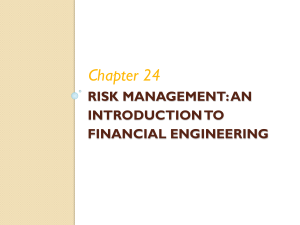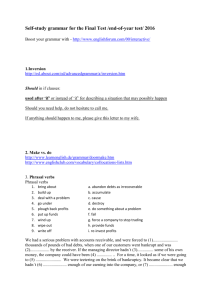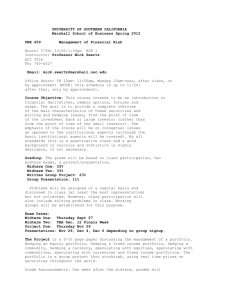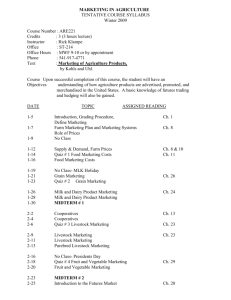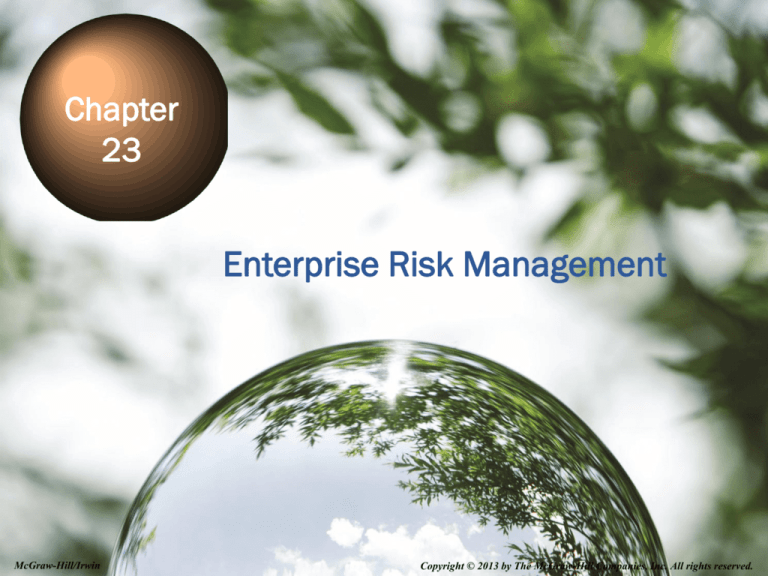
Chapter
23
Enterprise Risk Management
23-1
McGraw-Hill/Irwin
Copyright © 2013 by The McGraw-Hill Companies, Inc. All rights reserved.
Chapter Outline
•Hedging and Price Volatility
•Managing Financial Risk
•Hedging with Forward Contracts
•Hedging with Swap Contracts
•Hedging with Option Contracts
23-2
Chapter Outline
•Hedging and Price Volatility
•Managing Financial Risk
•Hedging with Forward Contracts
•Hedging with Swap Contracts
•Hedging with Option Contracts
23-3
What Risks?
Conducting business in a
global economy involves
risk.
Much of the risk is
associated with coping
with the unpredictable
future.
23-4
Enterprise Risk Management
(ERM)
ERM is the process to
identify, assess, and
where possible, to
mitigate the risks to
a firm
23-5
Risk Types
1.
2.
3.
4.
Hazard Risks
Financial Risks
Operational Risks
Strategic Risks
ERM seeks to view the business
holistically and understand how the
pieces of risk fit together.
23-6
What Risks?
Many companies address risk publically
as exemplified by Disney Corporation in
their annual report
23-7
Example: Disney’s Risk
Management Policy
Disney provides stated policies and procedures concerning
risk management strategies in its annual report:
The company tries to manage exposure to
interest rates, foreign currency, and the fair
market value of certain investments
Interest rate swaps are used to manage
interest rate exposure
23-8
Example: Disney’s Risk
Management Policy
Disney provides stated policies and procedures
concerning risk management strategies in its annual
report:
Options and forwards are used to
23-9
manage foreign exchange risk in both
assets and anticipated revenues
The company uses a VaR (Value at Risk)
model to identify the maximum 1-day
loss in financial instruments
Derivative securities are used only
for hedging, not speculation
Hedging Volatility
Recall that volatility in returns is a
classic measure of risk
Volatility in day-to-day business
factors often leads to volatility in cash
flows and returns
If a firm can reduce that volatility, it
can reduce its business risk
23-10
Hedging Volatility
Instruments have been developed to
hedge the following types of
volatility:
Interest Rate
Exchange Rate
Commodity Price
Quantity Demanded
23-11
Interest Rate Volatility
Debt is a key component of a firm’s capital
structure
Interest rates can fluctuate dramatically in
short periods of time
23-12
Interest Rate Volatility
Companies that hedge against changes in interest
rates can stabilize borrowing costs
This can reduce the overall risk of the firm
Available tools: forwards, futures, swaps, futures
options, and options
23-13
Exchange Rate Volatility
Companies that do business internationally
are exposed to exchange rate risk
The more volatile the exchange rates, the
more difficult it is to predict the firm’s cash
flows in its domestic currency
23-14
Exchange Rate Volatility
If a firm can manage its exchange rate risk, it can
reduce the volatility of its foreign earnings and
conduct a better analysis of future projects
Available tools: forwards, futures, swaps, futures
options
23-15
Commodity Price Volatility
Most firms face volatility in the costs of materials and
in the price that will be received when products are
sold
23-16
Commodity Price Volatility
Depending on the commodity, the company may be
able to hedge price risk using a variety of tools
This allows companies to make better production
decisions and reduce the volatility in cash flows
Available tools (depend on type of commodity):
forwards, futures, swaps, futures options, options
23-17
Chapter Outline
•Hedging and Price Volatility
•Managing Financial Risk
•Hedging with Forward Contracts
•Hedging with Swap Contracts
•Hedging with Option Contracts
23-18
The Risk Management
Process
Identify the types of price
fluctuations that will
impact the firm
Some risks are obvious;
others are not
23-19
The Risk Management
Process
Some risks may offset each other, so it is
important to look at the firm as a
portfolio of risks and not just look at
each risk separately
23-20
The Risk Management
Process
You must also look at the cost of
managing the risk relative to the
benefit derived
Risk profiles are a useful tool for
determining the relative impact of
different types of risk
23-21
Risk Profiles
Basic tool for identifying and
measuring exposure to risk
Graph showing the relationship
between changes in price versus
changes in firm value
Click on the icon to visit an online
publication dealing with risk
management
23-22
Risk Profiles
Similar to graphing the
results from a sensitivity
analysis
The steeper the slope of the
risk profile, the greater the
exposure and the greater the
need to manage that risk
23-23
Reducing Risk Exposure
The goal of hedging is to lessen the slope of
the risk profile
Hedging will not normally reduce risk
completely
For most situations, only price
risk can be hedged, not quantity
risk
You may not want to reduce risk
completely because you miss out
on the potential upside as well
23-24
Reducing Risk Exposure
Timing
Short-run exposure (transactions
exposure) – can be managed in a
variety of ways
Long-run exposure (economic
exposure) – almost impossible to
hedge - requires the firm to be
flexible and adapt to permanent
changes in the business climate
23-25
Chapter Outline
•Hedging and Price Volatility
•Managing Financial Risk
•Hedging with Forward Contracts
•Hedging with Swap Contracts
•Hedging with Option Contracts
23-26
Forward Contracts
A contract where two parties agree on the
price of an asset today to be delivered and
paid for at some future date
Forward contracts are legally binding on
both parties
They can be tailored to meet the needs of
both parties and can be quite large in size
23-27
Forward Contracts
Positions
Long – agrees to buy the
asset at the future date
Short – agrees to sell the
asset at the future date
Because they are negotiated
contracts and there is no exchange of
cash initially, they are usually limited
to large, creditworthy corporations
23-28
Forward Contracts
23-29
Hedging with Forwards
Entering into a forward contract can virtually
eliminate the price risk a firm faces
It does not completely eliminate risk unless there
is no uncertainty concerning the quantity
Because it eliminates the price risk, it prevents
the firm from benefiting if prices move in the
company’s favor
23-30
Hedging with Forwards
The firm also has to spend some time and/or
money evaluating the credit risk of the
counterparty
Forward contracts are primarily used to hedge
exchange rate risk
23-31
Futures Contracts
Futures contracts traded on an
organized securities exchange
23-32
Futures Contracts
Require an upfront cash payment
called margin
Small relative to the value of the
contract
“Marked-to-market” on a daily basis
Clearinghouse guarantees performance on all
contracts
The clearinghouse and margin requirements
virtually eliminate credit risk
23-33
Futures Quotes
Commodity, exchange, size, quote
units
The contract size is important when
determining the daily gains and losses
for marking-to-market
23-34
Futures Quotes
Delivery month
Open price, daily high, daily low,
settlement price, change from
previous settlement price, contract
lifetime high and low prices, open
interest
Open interest is how many
contracts are currently
outstanding
23-35
Futures Quotes
Delivery month
The change in settlement price times
the contract size determines the gain
or loss for the day
Long – an increase in the settlement
price leads to a gain
Short – an increase in the settlement
price leads to a loss
23-36
Hedging with Futures
The risk reduction capabilities of
futures are similar to those of
forwards
The margin requirements and
marking-to-market require an
upfront cash outflow and liquidity
to meet any margin calls that may
occur
23-37
Hedging with Futures
Futures contracts are standardized, so the firm
may not be able to hedge the exact quantity it
desires
Credit risk is virtually nonexistent
Futures contracts are available on a wide range
of physical assets, debt contracts, currencies, and
equities
23-38
Chapter Outline
•Hedging and Price Volatility
•Managing Financial Risk
•Hedging with Forward Contracts
•Hedging with Swap Contracts
•Hedging with Option Contracts
23-39
Swaps
A long-term agreement between two
parties to exchange cash flows based on
specified relationships
Can be viewed as a series of forward
contracts
Generally limited to large creditworthy
institutions or companies
23-40
Swaps
Interest rate swaps – the net cash flow
is exchanged based on interest rates
Currency swaps – two currencies are
swapped based on specified exchange
rates or foreign vs. domestic interest
rates
23-41
Example: Interest Rate Swap
Consider the following interest rate swap:
Company A can borrow from a bank at 8% fixed or
LIBOR + 1% floating (borrows fixed)
Company B can borrow from a bank at 9.5% fixed
or LIBOR + .5% (borrows floating)
Company A prefers floating and Company B prefers
fixed
23-42
By entering into a swap agreement, both A and B
are better off than they would be borrowing from
the bank with their preferred type of loan, and the
swap dealer makes .5%
Example: Interest Rate Swap
Company A
Swap Dealer
w/A
23-43
Pay
Receive
Net
LIBOR +
.5%
8.5%
8.5%
-LIBOR
Company B
9%
Swap Dealer
w/B
LIBOR +
.5%
Swap Dealer
Net
LIBOR +
9%
LIBOR +
.5%
LIBOR +
.5%
9%
-9%
LIBOR +
9.5%
+.5%
Swap Process
23-44
Chapter Outline
•Hedging and Price Volatility
•Managing Financial Risk
•Hedging with Forward Contracts
•Hedging with Swap Contracts
•Hedging with Option Contracts
23-45
Option Contracts
The right, but not the obligation, to buy
(sell) an asset for a set price on or
before a specified date
Call – right to buy the asset
Put – right to sell the asset
Exercise or strike price –specified price
Expiration date – specified date
23-46
Option Contracts
Buyer has the right to exercise the option; the seller is
obligated
Call – option writer is obligated to sell the asset if the
option is exercised
Put – option writer is obligated to buy the asset if the
option is exercised
Unlike forwards and futures, options allow a firm to
hedge downside risk, but still participate in upside
potential
The firm pays a premium for this benefit
23-47
Payoff Profiles: Calls
23-48
St…
Payoff
Payoff
Bu…
Se…
St…
Payoff Profiles: Puts
Sell a Put E = $40
Payoff
Payoff
Buy a Put with E = $40
Stock Price
23-49
Stock Price
Hedging Commodity Price
Risk with Options
“Commodity” options are generally futures options
23-50
Hedging Commodity Price
Risk with Options
Exercising a call:
Owner of the call receives a long position
in the futures contract plus cash equal to
the difference between the exercise price
and the futures price
Seller of the call receives a short position
in the futures contract and pays cash equal
to the difference between the exercise
price and the futures price
23-51
Hedging Commodity Price
Risk with Options
Exercising a put:
Owner of the put receives a short position
in the futures contract plus cash equal to
the difference between the futures price
and the exercise price
Seller of the put receives a long position in
the futures contract and pays cash equal to
the difference between the futures price
and the exercise price
23-52
Hedging Exchange Rate
Risk with Options
May use either futures options on currency or
straight currency options
Used primarily by corporations that do business
overseas
U.S. companies want to hedge against a
strengthening dollar (receive fewer dollars when
you convert foreign currency back to dollars)
23-53
Hedging Exchange Rate
Risk with Options
Buy puts (sell calls) on foreign currency
Protected if the value of the foreign currency
falls relative to the dollar
Still benefit if the value of the foreign
currency increases relative to the dollar
Buying puts is less risky
23-54
Hedging Interest Rate
Risk with Options
Can use futures options
Large OTC market for interest rate
options
23-55
Hedging Interest Rate
Risk with Options
Caps, Floors, and Collars
Interest rate cap prevents a floating
rate from going above a certain level
(buy a call on interest rates)
Interest rate floor prevents a floating
rate from going below a certain level
(sell a put on interest rates)
23-56
Hedging Interest Rate
Risk with Options
Caps, Floors, and Collars
Collar – buy a call and sell a put
The premium received from
selling the put will help offset the
cost of buying the call
If set up properly, the firm will
not have either a cash inflow or
outflow associated with this
position
23-57
Quick Quiz
What are the four major types of derivatives discussed
in the chapter?
How do forwards and futures differ? How are they
similar?
How do swaps and forwards differ? How are they
similar?
How do options and forwards differ? How are they
similar?
23-58
Comprehensive Problem
A call option has an exercise price of $50.
What is the value of the call option at expiration if the stock
price is $35? $75?
A put option has an exercise price of $30.
What is the value of the put option at expiration if the stock
price is $25? $40?
23-59
Terminology
•Hedging
•Hedging Volatility
•Forward Contracts
•Future Contracts
•Future Quotes
•Swaps
•Option Contracts
•Commodities
23-60
Key Concepts and Skills
•Explain how companies
face risk exposures and
how they hedge against
these risks.
•Define the difference
between forward and
futures contracts.
23-61
Key Concepts and Skills
•Describe how swaps
and options can
be used for hedging.
•Compute the value of a put
and call option.
23-62
What are the most important
topics of this chapter?
1. Firms face risk associated with
changes in interest rates, exchange
rates of foreign currency, costs of
materials and the price that they can
sell their products.
2. Firms use hedging to protect
themselves against these risks.
23-63
What are the most
important topics of this
chapter?
3. Forward, Futures, Swap and Option
contracts are the financial
instruments to deal with this
volatility.
4. Risk is never removed entirely; it can
be mitigated by investing in contracts.
23-64
23-65



